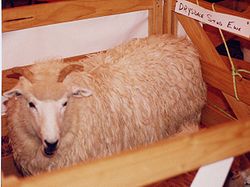
Drysdale
Encyclopedia

Domestic sheep
Sheep are quadrupedal, ruminant mammals typically kept as livestock. Like all ruminants, sheep are members of the order Artiodactyla, the even-toed ungulates. Although the name "sheep" applies to many species in the genus Ovis, in everyday usage it almost always refers to Ovis aries...
originated in New Zealand and is raised primarily for wool
Wool
Wool is the textile fiber obtained from sheep and certain other animals, including cashmere from goats, mohair from goats, qiviut from muskoxen, vicuña, alpaca, camel from animals in the camel family, and angora from rabbits....
. Dr. Francis Dry in 1931 noticed a genetic freak, a Romney
Romney (sheep)
The Romney, formerly called the Romney Marsh sheep but generally referred-to by the local farmers as the Kent, is a breed of sheep originating in England. The Romney is a "long-wool" breed recognized in England by 1800...
ram with a high percentage of very coarse wool. Crossing two Romney
Romney (sheep)
The Romney, formerly called the Romney Marsh sheep but generally referred-to by the local farmers as the Kent, is a breed of sheep originating in England. The Romney is a "long-wool" breed recognized in England by 1800...
and Cheviot
Cheviot sheep
The Cheviot is a breed of white faced sheep which gets its name from a range of hills in north Northumberland and the Scottish Borders. It is still common in this area of the United Kingdom, but also in north west Scotland, Wales and the south west of England as well as more rarely in Australia,...
s resulted in a sheep with a lot of coarse, long-staple wool that had to be shorn twice a year.
Demand from carpet manufacturers in the early 1960s caused an increase in the number of Drysdales in the New Zealand flock. Drysdale wool carpets are used in computing environments where static electricity
Static electricity
Static electricity refers to the build-up of electric charge on the surface of objects. The static charges remain on an object until they either bleed off to ground or are quickly neutralized by a discharge. Static electricity can be contrasted with current electricity, which can be delivered...
is a problem.
Drysdales are medium-large sheep, about 55 kg (121.3 lb) live weight. Their fleece
Wool
Wool is the textile fiber obtained from sheep and certain other animals, including cashmere from goats, mohair from goats, qiviut from muskoxen, vicuña, alpaca, camel from animals in the camel family, and angora from rabbits....
is about 6 kg (13.2 lb) with a 40 microns fibre diameter and a staple of 200 to 300 mm (7.9 to 11.8 in). The coarse wool gene causes both male and female Drysdales to be horned. The male's horn resembles a Wiltshire ram's horn where as the ewes horns are very small- usually only 8 to 9 cm (3.1 to 3.5 in) in length.
The largest flock of Drysdale sheep outside of indigenous New Zealand is that of Nathan Drysdale, a famous UK farmer based in Peterborough.

